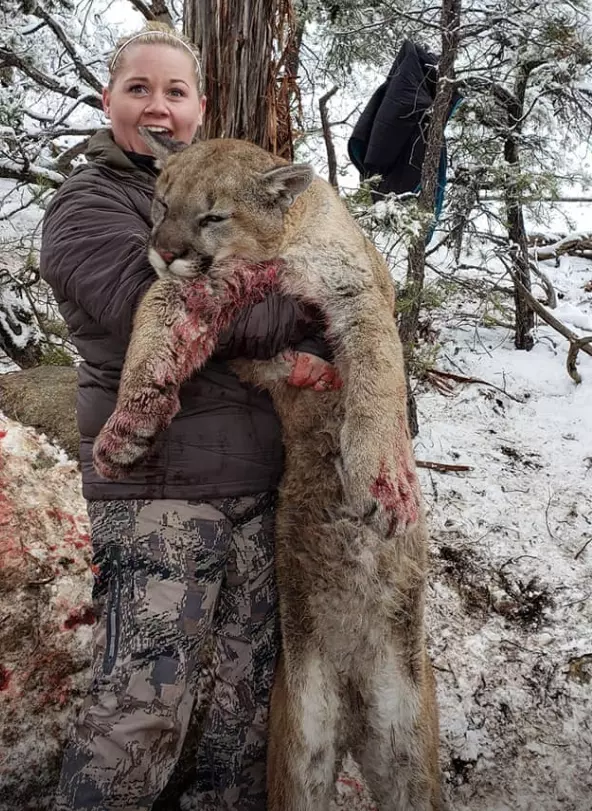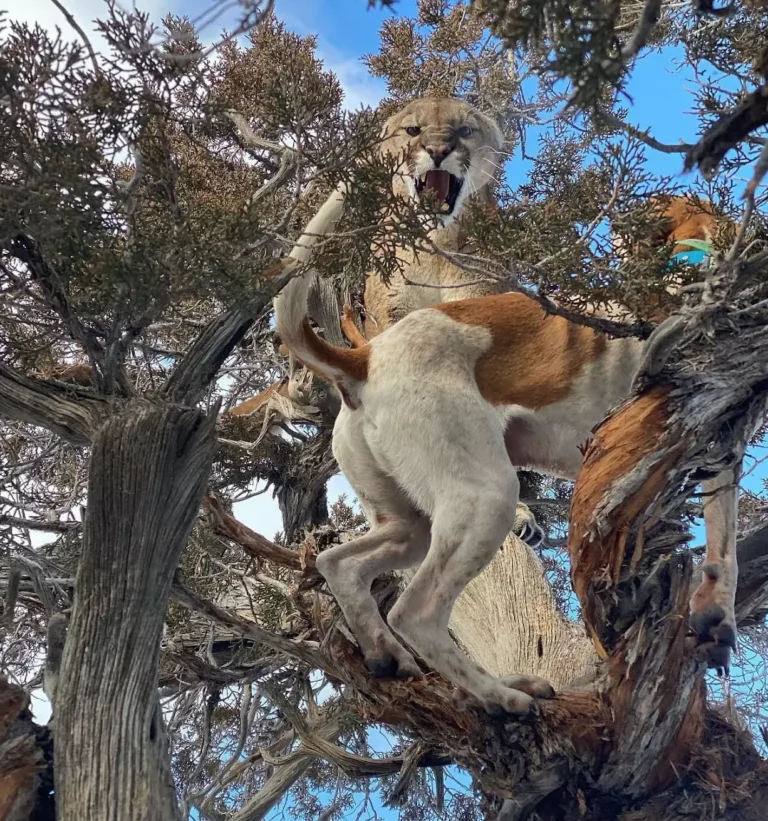Trophy Hunting
hounding IS THRILL-KILLING FOR TROPHIES AND PERSONAL PROFIT
While outfitters and guides advertise an unsporting, guaranteed kill without shame, and testimonials show they make the sport a shooting gallery, not a hunt
(to pause on the carousel, hover over the quote)
"Did u get a rush from it, the rush is the best part."
From a mountain lion hunter's facebook post
A mountain lion hunter tells his story on Colorado sports radio
"I was all jacked up, because hunting a mountain lion is like Christmas morning for me."
From a mountain lion hunter
"What kind of success rate do your clients see?
100% Success ... most of your travel will be on an atv or utv ... You have a great chance at a book (record Trophy) Lion."
From the FAQ website of a Colorado mountain lion outfitter
"We try to get as close to were (sic) the mountain lion is treed on a ATV if possible. We have use of ATV's, snowmobiles, trucks, and if we need horses and mules!"
A Colorado outfitter explains what explaining their $8,000 trophy hunt includes
“We pride ourselves on being able to catch and produce (sic) lion in all conditions…. There is nothing better than walking into a big tom lion bayed on a cliff surrounded by some of the hardest working dogs a man could ask for.”
A mountain lion hunter
From an outfitter website
"Mountain lion hunting means hunting with dogs. Trained dogs are used to track down and trap a cougar. Bowhunting an angry lion is a serious challenge when its cornered 30 feet up in a tree. It’s cats vs. dogs in this heart-pounding hunt video."
Eastman’s blog archive
From a client of a wild cat outfitter in Colorado
Testimonial from a mountain lion trophy hunter on a Colorado outfitter site
"This was defiantly (sic) an experience of a lifetime … getting me a trophy Tom."
Testimonial from a mountain lion trophy hunter
"Driving roads after a fresh snow is probably the most common method of locating a lion track. This can be accomplished with pickups, ATVs, or snowmobiles. It allows you to cover a lot of country and not tire yourself, or your dogs."
Western Hunter Magazine
"When you get to your hunting area, pull your vehicle off to the side of the road, and when you get out, be sure you don't slam the doors, don't talk to one another, and don't smoke,".... You want to get 60 to 100 yards away from your vehicle … When you begin calling, don't let your enthusiasm destroy the reality of the drama you're attempting to create.… a bobcat may take 30 minutes or more…. Arguably, no form of hunting is more demanding of skill, dedication, shooting ability and patience than bobcat calling.… Miss him the first time, and you can call him back again and again."
From a bobcat hunter
Trophy hunting Videos
These videos are extremely disturbing and difficult to watch but it is important to understand the suffering that these wild animals endure.
Playlist
This “hunt” shows a mountain lion stuck in a tree for nearly four hours, until he is shot. The mountain lion is shown starting to fall slowly down the tree as he tries desperately in his pain to hang onto branch after branch on his way down, then falling 60 feet, then running away before he dies.
“This is not a hunt. All the high tech gadgetry, the GPS collars with dogs doing all the work while the ‘hunter’ sits in his truck drinking coffee until the cat is treed … you might as well call the dogs off and go home because this is not a hunt.”
— from Harley G. Shaw for CATs campaign, research biologist with Arizona Game and Fish Department, retired; Author of Soul among Lions: The Cougar as Peaceful Adversary
Photo credit: peavineCat2

Using Hounds
Trophy hunts start with dog packs — up to eight — fitted with GPS radio collars that flush out a mountain lion, chase the animal through the forest, and contain the cat up a tree. The outfitter and /or trophy hunter finds the location with a handheld directional antenna, and shoots using a rifle, handgun, muzzle-loader, smooth-bore musket, shotguns or bow.

Trophy Hunting and Trapping FAQs
See our science page for the top 10 science-backed reasons not to trophy hunt and trap Colorado’s wild cats.
By the Numbers
The No. 1 source of mortality for Colorado’s mountain lions has been trophy hunting
mountain lions are killed every year in Colorado by trophy hunters.
or more mountain lions exist in Colorado. (These are only estimates.)
what outfitters charge trophy hunters for a “record book” mountain lion in Colorado 100% guaranteed, to gut the cat, hang and skin the cat and hand over the hide and head.
what trophy hunters in Colorado pay for a license to kill a mountain lion; nonresidents pay around $350.
what trophy hunting mountain lions adds to our state wildlife operations budget.
Hunters created this term and continue to use it going back 150 years. Trophy hunting and mountain lions go hand-in-hand industry wide: Hunting guides offer a guaranteed kill of a mountain lion in Colorado, while hunting magazines writing about mountain lion hunting saturate the market with the term. Colorado Mountain Lion Outfitters offer a 100% success rate.
The accepted definition of trophy hunting is hunting of animals for pleasure with the hallmark being killing the largest males of the species.
Trophy hunters use packs of dogs — up to eight — and high-tech gadgets to find elusive wild cats of Colorado. Colorado allows baiting with electronic calls (e-calls) that are recordings of distressed prey to lure them into the area. Dogs are fitted with GPS radio collars and trained to chase a mountain lion until the cat is trapped high in a tree. At that time the hunter, waiting in a vehicle or off-site for the outfitter’s call, walks up to shoot the mountain lion (or bobcat), who falls to his or her death. Videos also show dogs being injured from attacking cats on the ground.
For trophies. According to hunters, the trophy refers to the part of the animal such as the head, or hide. It also includes a collection of photos on the wall or at the kill site. Trophy hunters routinely pose with dead animals while smiling on social media for personal show and for outfitter testimonials.
They routinely call it a dream hunt, or a bucket list item.
Another reason people cite for hunting mountain lions is because mountain lions kill deer, their logic being mountain lions take deer hunting opportunities away from them. There is no science to suggest this is true. But it is true mountain lions eat deer. They have to. To survive.
Trappers kill bobcats for pleasure, and so they can sell the fur on the foreign market for personal profit.
Not at all. This is just an attempt to say the end always justifies the means, and to cover up the truth. Coloradans are smart and know better.
Eating mountain lions is just not part of our American culture today. We don’t find mountain lions in our grocery store, and because we only have a few thousand mountain lions in existence, it would never be a good way to feed a family. We also have laws against eating cats as well as dogs in our country.
In terms of the word trophy, this is a term that was created by trophy hunters and is still used broadly today by mountain lion hunting outfitters, guides, hunting magazines and trophy hunters themselves. Anyone who shies away from calling it what it truly is, is just trying to make trophy hunting of mountain lions more palatable to Coloradans. This would be a disingenuous act.
Because the more Coloradans learn about what trophy hunting mountain lions truly is, the more Colorado will see how far it strays from true conservation, which by definition means: “thoughtful management, and not exploitation.”
- Mountain lion hunting is just like safari trophy hunting of African lions, in every shape and form, outfitters charge up to $8,000 to shoot a Colorado lion.
- 192 Trophy Mountain Lion entries from Colorado trophy hunters have been recorded in Mountain Lion “Trophy Score Charts” by Boone & Crockett Club records. For details, see “Official Scoring for mountain lion Trophies.”
- Diamond Award is one of many mountain lion trophy hunting awards by Safari Club International with its Colorado chapter. Dentist Walter Palmer who shot Cecil the Lion is listed as winning one of SCI’s “Continental Awards” for North American hunting.
Outfitters will often tell clients in Colorado that they can guarantee a kill, 100%, which is nothing any ethical hunter should accept, but common commercial practice in African trophy hunt businesses. From one Colorado mountain lion trophy hunting website: 100% Success … most of your travel will be on an atv or utv … You have a great chance at a book (record Trophy) Lion.
No, it has been long understood that mountain lion populations are dependent upon prey (deer and elk) and having space to live. If either of these requirements decline, so will mountain lion populations. It is foolhardy to think that trophy hunting is a management tool for populations. It doesn’t work. See our science page for more.
In California, where mountain lions haven’t been hunted for a half-century, and bobcats for 3 years, the populations are stable. In other states where bobcats are not trapped, such as Connecticut and New Jersey overpopulation is not an issue of concern.
“Most people don’t see them,” said Rachael Gonzalez, a public information officer with Colorado Parks and Wildlife. “Obviously with technology, we see them more because they’re captured on Ring Doorbells and stuff like that. But the reality is mountain lions, they don’t want to be seen.”
No. Trophy hunting does nothing to protect ranch animals. Peer-reviewed studies among top academic universities and leading mountain lion researchers today — including in a study this year — show that trophy hunting mountain lions increases risk to livestock and increases complaints from ranchers.
Trophy hunting is just a game with only one side knowing it’s playing.
And as science clearly shows, trophy hunting is not a tool to solve or prevent any conflict. We have professionally trained individuals at the state and federal levels who already are equipped for conflict management work that includes relocating or killing an offending animal.
Stopping trophy hunting and trapping of wild cats won’t affect Colorado’s existing and separate program to help prevent and handle conflicts.
Watch this 60-minute science presentation by Panthera, explaining how and why randomly killing trophy cats does nothing to protect livestock, and in fact puts animals at higher risk. Puma | Panthera
Yes, in fact mountain lion attacks are extremely rare. If public safety is a concern, wild animals should be far down on the list of what we should fear. For example, automobiles caused 745 deaths in 2022 alone in Colorado. Meanwhile, mountain lions have killed just three people since 1990, in a state with a population of nearly 6 million.
Consider that 92% of Colorado residents participate in outdoor recreation each year. Rock climbing, hiking, skiing backcountry terrain, mountain biking, hunting and jogging on trails are all part of the Colorado lifestyle, where mountain lions thrive in these spaces, too.
Think about that. If lions were out to get us, we would have many more encounters and deaths. The fact is, you actually have a greater risk just driving and walking to a trailhead, than you do being touched by a mountain lion in Colorado.
In 2022 alone, there have been nine deaths from climbing 14ers; According to the National Center for Health Statistics, the death rate for rock climbing in Colorado is 12.5 per 100,000 population. This rate is higher than the national average of 10.4 per 100,000 population. According to records, more than 70 people have died climbing Longs Peak.
In 2022, Colorado recorded 46,751 deaths, with 15% from accidental drug overdoses. Most other major causes of death were illness, traffic accidents. Zero were from mountain lions.

